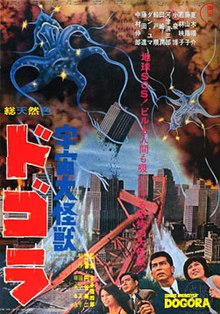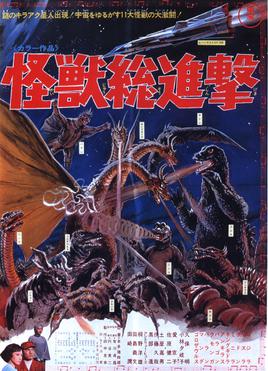
Destroy All Monsters is a 1968 Japanese epic kaiju film directed by Ishirō Honda, with special effects directed by Sadamasa Arikawa and supervised by Eiji Tsuburaya. The film, which was produced and distributed by Toho Co., Ltd, is the ninth film in the Godzilla franchise, and features eleven monster characters, including Godzilla, Mothra, Rodan, King Ghidorah, Anguirus, and Minilla. The film stars Akira Kubo, Jun Tazaki, Yukiko Kobayashi and Yoshio Tsuchiya.
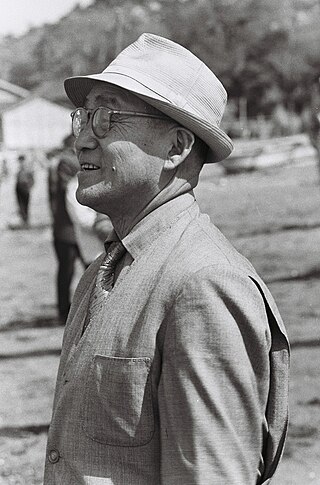
Eiji Tsuburaya was a Japanese special effects director, filmmaker, and cinematographer. A co-creator of the Godzilla and Ultraman franchises, he is considered one of the most important and influential figures in the history of cinema. Tsuburaya is known as the "Father of Tokusatsu", having pioneered Japan's special effects industry and introduced several technological developments in film productions. In a career spanning five decades, Tsuburaya worked on approximately 250 films—including globally renowned features directed by Ishirō Honda, Hiroshi Inagaki, and Akira Kurosawa—and earned six Japan Technical Awards.

Kaiju is a Japanese term that is commonly associated with media involving giant monsters. Its widespread contemporary use is credited to tokusatsu director Eiji Tsuburaya and filmmaker Ishirō Honda, who popularized the kaiju film genre by creating the Godzilla franchise and its spin-offs. The term can also refer to the monsters themselves, which are usually depicted attacking major cities and battling either the military or other creatures.

Gamera is a fictional monster, or kaiju, originating from a series of Japanese films. Debuting in the 1965 film Gamera, the Giant Monster, the character and the first film were intended to compete with the success of Toho's Godzilla film series. Since then, Gamera has become a Japanese icon in his own right, appearing in a total of 12 films produced by Daiei Film and later by Tokuma Shoten and Kadokawa Daiei Studio respectively, and various other media such as novelizations, manga, video games, and so on.

Ghidorah, the Three-Headed Monster is a 1964 Japanese kaiju film directed by Ishirō Honda, with special effects by Eiji Tsuburaya. Produced and distributed by Toho Co., Ltd., it is the fifth film in the Godzilla franchise, and was the second Godzilla film produced that year, after Mothra vs. Godzilla. The film stars Yosuke Natsuki, Hiroshi Koizumi, Akiko Wakabayashi, with Haruo Nakajima as Godzilla, Masanori Shinohara as Rodan, and Shoichi Hirose as King Ghidorah. In the film, an extraterrestrial from Venus, possessing the body of a princess, warns humanity of the pending destruction by the alien-dragon Ghidorah, with Godzilla, Rodan, and Mothra being their last hope for survival.

Tokusatsu is a Japanese term for live-action films or television programs that make heavy use of practical special effects. Credited to special effects director Eiji Tsuburaya, tokusatsu mainly refers to science fiction, war, fantasy, or horror media featuring such technology but is also occasionally dubbed a genre itself. Its contemporary use originated in the Japanese mass media around 1958 to explain special effects in an easy-to-understand manner and was popularized during the "first monster boom" (1966–1968). Prior to the monster boom, it was known in Japan as tokushu gijutsu or shortened tokugi.

Gamera, the Giant Monster is a 1965 Japanese kaiju film directed by Noriaki Yuasa, with special effects by Yonesaburo Tsukiji. Produced and distributed by Daiei Film, it is the first film in the Gamera franchise and the Shōwa era. The film stars Eiji Funakoshi, Harumi Kiritachi, and Junichiro Yamashita. In the film, authorities deal with the attacks of Gamera, a giant prehistoric turtle unleashed in the Arctic by an atomic bomb.

Varan is a fictional monster, or kaiju, that first appeared in the 1958 film Varan the Unbelievable directed by Ishirō Honda and produced and distributed by Toho. The creature is depicted as a giant, dinosaurian, prehistoric reptile capable of gliding flight. It later appeared in the 1968 film Destroy All Monsters, the ninth film in the Godzilla franchise.

King Kong Escapes is a 1967 kaiju film directed by Ishirō Honda, with special effects by Eiji Tsuburaya. The film was a Japanese–American co-production between Toho and Rankin/Bass, and stars Rhodes Reason, Linda Miller, Akira Takarada, Mie Hama, Eisei Amamoto, with Haruo Nakajima as King Kong and Hiroshi Sekita as Mechani-Kong and Gorosaurus. The film is loosely based on Rankin/Bass' series The King Kong Show, and was the second and final Toho-produced film featuring King Kong, until its 2021 collaboration with Warner Bros on Godzilla vs. Kong. King Kong Escapes was released in Japan on July 22, 1967, and released in the United States on June 19, 1968. It is the fourth entry in the King Kong franchise.

Ultra Q is a 1966 Japanese tokusatsukaiju television series created by Eiji Tsuburaya. Produced by Tsuburaya Productions, it is the first entry in the long-running Ultraman franchise and was broadcast on Tokyo Broadcasting System (TBS) from January 2 to July 3, 1966, with a total of 28 episodes. This series was followed two weeks later by the more popular Ultraman (1966), the second entry in the franchise.
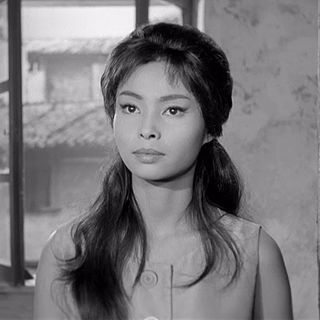
Akiko Wakabayashi is a retired Japanese actress.

Varan the Unbelievable is a 1958 Japanese kaiju film directed by Ishirō Honda, with special effects by Eiji Tsuburaya. Produced and distributed by Toho Co., Ltd, it stars Kōzō Nomura, Ayumi Sonoda, and Koreya Senda, with Haruo Nakajima as Varan. In the film, a reporter's investigation into two mysterious deaths in Japan's mountains leads to the discovery of a giant lake monster, wrecking its way towards civilization.

Rodan is a 1956 Japanese kaiju film directed by Ishirō Honda, with special effects by Eiji Tsuburaya. Produced and distributed by Toho Studios, it is the debut film of the titular monster Rodan, Toho's first kaiju film to be shot in color, and one of several giant monster films that found an audience outside Japan. Rodan would become a staple monster later crossing over into the Godzilla franchise. The film stars Kenji Sahara and Yumi Shirakawa.
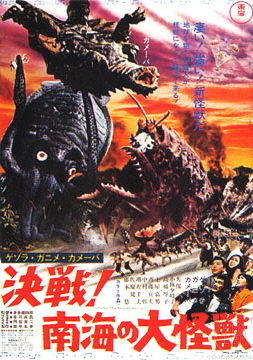
Space Amoeba is a 1970 Japanese kaiju film directed by Ishirō Honda, written by Ei Ogawa, and produced by Tomoyuki Tanaka and Fumio Tanaka, with special effects by Sadamasa Arikawa. Produced and distributed by Toho Studios, the film stars Akira Kubo, Atsuko Takahashi, Yukiko Kobayashi, Kenji Sahara, Yoshio Tsuchiya, and Yu Fujiki, with Haruo Nakajima portraying both Gezora and Ganimes.

The X from Outer Space is a 1967 Japanese science fiction kaiju film directed by Kazui Nihonmatsu, and stars Eiji Okada and Toshiya Wazaki.

Ultraman: Monster Movie Feature is a 1967 Japanese superhero kaiju film directed by Hajime Tsuburaya, with special effects by Koichi Takano. Produced by Tsuburaya Productions and distributed by Toho Co., Ltd., it is the first film in the Ultraman franchise, consisting entirely of re-edited material from the original series. In the film, an extraterrestrial defends Earth from giant monsters who pose a threat to humanity.

Shoichi Hirose, occasionally miscredited as Masakazu Hirose and nicknamed Solomon for his survival in the naval Battle of the Eastern Solomons, was a Japanese actor. Hirose portrayed Godzilla's archenemy King Ghidorah and King Kong in King Kong vs. Godzilla, along with several "tough guy" roles.

Monster Seafood Wars is a 2020 Japanese kaiju film directed by Minoru Kawasaki. The film is loosely based on an unmade film featuring a giant octopus proposed by Eiji Tsuburaya prior to production of the original 1954 Godzilla film.

Akira Watanabe was a Japanese special effects art director who worked on 38 films in a career spanning 25 years.

Eiji Tsuburaya (1901–1970) was a Japanese special effects director and filmmaker who worked on roughly 250 films throughout his five-decade career. Having pioneered and popularized the special effects sector of the Japanese film industry, he is popularly known as the "Father of Tokusatsu". Tsuburaya started his career in the Japanese film industry as a cinematographer for several successful dramas and jidaigeki films in the early 1920s. His directorial debut was the propaganda documentary film Three Thousand Miles Across the Equator, which he filmed in the Pacific Ocean on the Asama for most of 1935. Following the completion of photography on this film, he worked as the cinematographer and had his debut as special effects director on Princess Kaguya (1935). It was one of Japan's first major productions to feature special effects. The next year, Tsuburaya made his dramatic directorial debut with the release of Folk Song Collection: Oichi of Torioi Village and had substantial success staging the special effects for Arnold Fanck's The Daughter of the Samurai.
